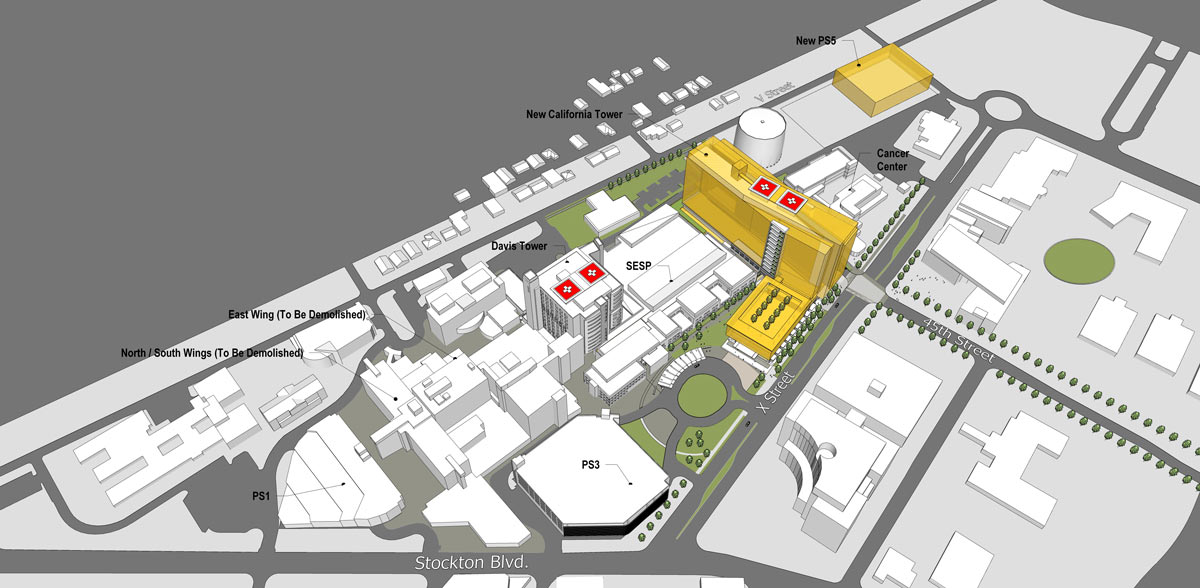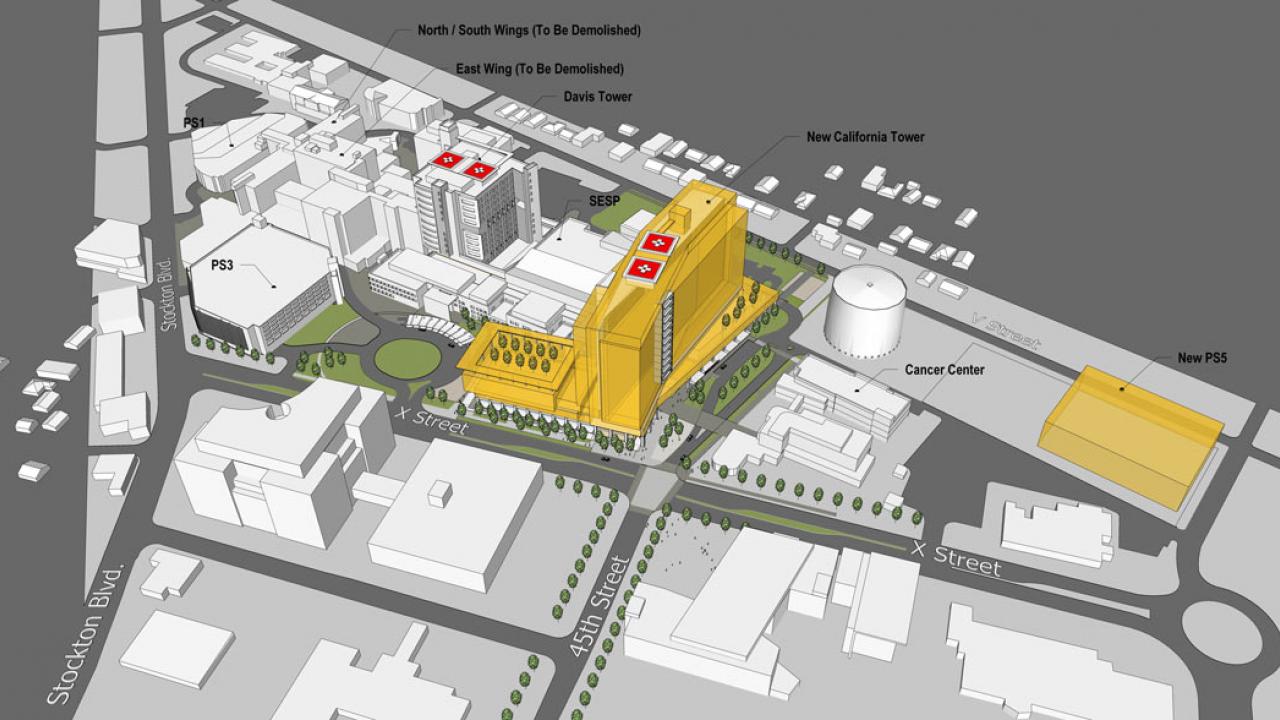UC Davis Health on Friday (Feb. 26) launched the planning and environmental review process to rebuild and expand UC Davis Medical Center. The project would add beds and private rooms while addressing state earthquake safety mandates, removing facilities that no longer comply and replacing them with a 16-story hospital building and five-story pavilion.
Planning and design for the $3.75 billion project is expected to take three years, with early construction efforts starting in late 2021 and project completion in 2030.
UC Davis plans to solicit extensive community input on the planned California Tower, including surrounding open space areas and opportunities for neighborhood connectivity with the campus, through a university-led outreach process modeled on the one the city of Sacramento and UC Davis are jointly conducting for Aggie Square innovation district.
For Aggie Square, UC Davis and developer Wexford Science + Technology are in the final stages of negotiating with the city on an extensive agreement detailing the community benefits partnership that will spell out the ways that construction and operation of the $1.1 billion district will help people in the nearby communities.
The agreement will outline the commitments of UC Davis, Wexford and the city to provide jobs, job training, affordable housing, better transportation options and youth education. UC Davis plans to conduct similar outreach as part of the planning for the medical center project, including the creation of an advisory committee comprising neighborhood representatives.
“We will build on the partnerships emerging at Aggie Square with our city leadership and our neighbors,” said Hendry Ton, associate vice chancellor for Health Equity, Diversity and Inclusion. “We’re re-envisioning our role as a traditional health provider to one that encompasses the full context of health equity.”
Rooms of the future
When completed, the expanded hospital would contain 700 licensed beds, up from 625 today. But the hospital’s square footage would nearly double to accommodate more private rooms — approximately 400 in the new tower; single-patient rooms, officials said, enhance recovery and healing, and help reduce infection transmission.
Also, a greater number of rooms would be acuity-adaptable, meaning they would be designed as intensive-care-unit-capable rooms with air isolation so that they could be used to care for patients of any acuity level, should a surge in critical care cases arise, such as during a pandemic, massive wildfire or radiation leak.
In addition, rooms would be embedded with, and designed for, the latest technologies, easily enabling rooms to accommodate medical and surgery patients if needed. The adaptability of the patient rooms to meet a critical care surge means the new facilities — with the potential for creating 450 ICU rooms – would be positioned to meet regional needs for the next 50 years.
‘Unique planning’
“While there is an overall reduction in the need for hospital beds across the region, we are uniquely planning for more beds,” said David Lubarsky, CEO of UC Davis Health and vice chancellor of Human Health. “In the not-too-distant future, fewer people per capita will need to be hospitalized, due to evolving health technologies, same-day surgeries, telehealth visits and being able to remotely monitor a patient’s vital signs.
“Low-acuity care in the inpatient arena will virtually disappear over the next decade. However, those individuals who do require hospitalization will likely require longer stays for complex surgeries or other critical care services, such as trauma care, that we provide.
“We will continue to work with community hospital partners to increase the level and amount of care they provide locally while we concentrate on patients that require advanced technologies and coordinated subspecialists available in an academic center, and which leads to the superior outcomes we deliver in those cases.”
Officials noted UC Davis Medical Center’s historic role in caring for underserved communities and the most vulnerable populations, especially in terms of providing specialty, in-patient hospital services. At this time, Medi-Cal patients comprise 41 percent of the medical center’s inpatient work.
The core of our everyday mission is to increase the health of the community overall. That includes ensuring a robust health care safety net for historically marginalized populations, officials said.
Planned footprint

The new tower would be built on existing parking areas at the corner of 45th and X streets, and would fit within the medical center’s planned footprint. Two helipads are planned for emergency cases and patient transfers, bringing to four the number of helipads at the medical center.
Part of the need for the new facilities is the forced closure and demolition of older portions of the medical center that do not meet the state’s 2020 and 2030 seismic safety requirements. Demolition of the 1950s-era north and south hospital wings, whose nine-story profiles can be seen from Stockton Boulevard, is slated to be completed in 2030.
Health system officials expect the UC Board of Regents to consider the project later this year. Some initial drawings have been created for illustration purposes, but design work is just now starting.
Improving health for all
Along with improving UC Davis’ workforce development programs and partnering with other businesses and community groups, the California Tower project is expected to create hundreds of prevailing wage construction jobs and thousands of new health care positions for the surrounding community, a benefit of being home to an anchor institution like UC Davis Medical Center. the health system campus.
Place-based and mission-driven, anchor institutions represent stable, long-lasting centers of employment and services within the fabric of a city. These anchor institutions can leverage economic power alongside human and intellectual resources to improve the long-term health and social welfare of surrounding communities.
With the project creating hundreds of construction jobs, as well as tapping local vendors and suppliers for materials, California Tower will bring an economic boost to the Sacramento area. Once completed, the expanded medical center will permanently employ clinical professionals and skilled employees alike.
New job training programs for the local community are planned as part of the project — UC Davis Health has already added 1,500 mostly union jobs in just the last three years and is committed to making sure those employment benefits clearly extend to local applicants. The new jobs and local investment can help address historic impediments caused by poverty and discrimination, both of which are associated with reduced access to safe environments and good health.
“We recognize that significant disparities and inequities in health outcomes exist for Sacramento’s underserved communities,” Lubarsky said. “The new California Tower will clearly benefit hospital patients. But it also can help address the social determinants of health, inequities that have for far too long placed residents and families living in the neighborhoods near UC Davis Medical Center at higher risk of poor health and fewer opportunities for improving their quality of life.
“Uplifting the economic trajectory of the people in the communities around us through this building project and its subsequent operation will provide resources necessary for those currently underserved to achieve better health”
More information
UC Davis released its notice of preparation Friday (Feb. 26), indicating the health system is preparing an environmental impact report, or EIR, for the California Tower project. More information is available here. A virtual forum is scheduled from 4:30 to 6:30 p.m. Wednesday, March 17, to brief interested parties on the scope of the project and obtain the views of agency representatives and the public on the scope and content of the draft EIR and potentially significant environmental impacts related to the project. Access information for the virtual forum will be posted here when available.
UC Davis Health will work with local government officials and community groups to host other public forums during the planning process. Look for more information here as it becomes available.
Media Resources
Charles Casey, 916-734-9048, charles.casey@ucdmc.ucdavis.edu
